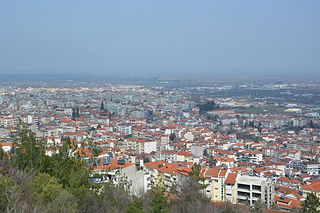| New Testament manuscript | |
| Text | Gospels † |
|---|---|
| Date | 8th-century |
| Script | Greek |
| Now at | ? |
| Size | ? |
| Type | ? |
| Category | ? |
Uncial 0168 (in the Gregory-Aland numbering), is a Greek uncial manuscript of the New Testament. It was dated paleographically to the 8th-century. The codex contained the four Gospels, with some lacunae. It was a palimpsest. The codex is now lost, and further details are unavailable. [1]

Greek is an independent branch of the Indo-European family of languages, native to Greece, Cyprus and other parts of the Eastern Mediterranean and the Black Sea. It has the longest documented history of any living Indo-European language, spanning more than 3000 years of written records. Its writing system has been the Greek alphabet for the major part of its history; other systems, such as Linear B and the Cypriot syllabary, were used previously. The alphabet arose from the Phoenician script and was in turn the basis of the Latin, Cyrillic, Armenian, Coptic, Gothic, and many other writing systems.

A manuscript was, traditionally, any document that is written by hand -- or, once practical typewriters became available, typewritten -- as opposed to being mechanically printed or reproduced in some indirect or automated way. More recently, the term has come to be understood to further include any written, typed, or word-processed copy of an author's work, as distinguished from its rendition as a printed version of the same. Before the arrival of printing, all documents and books were manuscripts. Manuscripts are not defined by their contents, which may combine writing with mathematical calculations, maps, explanatory figures or illustrations. Manuscripts may be in book form, scrolls or in codex format. Illuminated manuscripts are enriched with pictures, border decorations, elaborately embossed initial letters or full-page illustrations. A document should be at least 75 years old to be considered a manuscript.

The New Testament is the second part of the Christian biblical canon, the first part being the Old Testament, based on the Hebrew Bible. The New Testament discusses the teachings and person of Jesus, as well as events in first-century Christianity. Christians regard both the Old and New Testaments together as sacred scripture. The New Testament has frequently accompanied the spread of Christianity around the world. It reflects and serves as a source for Christian theology and morality. Extended readings and phrases directly from the New Testament are incorporated into the various Christian liturgies. The New Testament has influenced religious, philosophical, and political movements in Christendom and left an indelible mark on literature, art, and music.
Currently it is dated by the INTF to the 8th century. [1] [2] The codex was housed at the Melissa Brothers in Veria. [1]

Veria, officially transliterated Veroia, historically also spelled Berea or Berœa, is a city in Macedonia, northern Greece, located 511 kilometres north-northwest of the capital Athens and 73 km (45 mi) west-southwest of Thessalonica.
The text-type of this codex is unknown. Kurt Aland did not place it in any Category. [1]

A 'codex, plural codices, is a book constructed of a number of sheets of paper, vellum, papyrus, or similar materials. The term is now usually only used of manuscript books, with hand-written contents, but describes the format that is now near-universal for printed books in the Western world. The book is usually bound by stacking the pages and fixing one edge to a spine, which may just be thicker paper, or with stiff boards, called a hardback, or in elaborate historical examples a treasure binding.

Kurt Aland, was a German theologian and biblical scholar who specialized in New Testament textual criticism. He founded the Institut für neutestamentliche Textforschung in Münster and served as its first director from 1959–83. He was one of the principal editors of Nestle-Aland – Novum Testamentum Graece for the Deutsche Bibelgesellschaft and The Greek New Testament for the United Bible Societies.

New Testament manuscripts in Greek are categorized into five groups, according to a scheme introduced in 1981 by Kurt and Barbara Aland in The text of the New Testament. The categories are based on how each manuscript relates to the various text-types. Generally speaking, earlier Alexandrian manuscripts are category I, while later Byzantine manuscripts are category V. Aland's method involved considering 1000 passages where the Byzantine text differs from non-Byzantine text. The Alands did not select their 1000 readings from all of the NT books; for example, none were drawn from Matthew and Luke.

